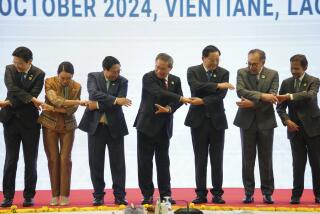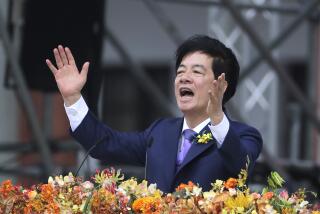Taiwan president makes waves with South China Sea visit
- Share via
Reporting from Taipei, Taiwan — Wading into choppy political waters, Taiwan’s outgoing president Thursday paid a visit to a disputed islet in the South China Sea and called for peace as China, Vietnam, Malaysia and the Philippines vie more aggressively for territory and influence in the region.
Ma Ying-jeou largely couched his visit to Taiping Island, also known as Itu Aba, in conciliatory and eco-friendly terms. But even before his airplane touched down on the 0.2-square-mile outcropping, the trip was drawing criticism from U.S. officials, with one calling it “extremely unhelpful” for resolving disagreements.
Taiping -- the largest naturally occurring land mass in the Spratly Islands -- is claimed by the Philippines, mainland China and Vietnam and Taiwan, but is administered by Taiwan. Taiwan’s government under Ma has expended considerable effort to make the islet “low carbon” and turn it into a haven for storm-battered vessels of any nationality.
The palm-covered islet boasts a 10-bed hospital, a lighthouse and $129 million worth of solar panels, along with a small airport for military use. The hospital’s three doctors can treat people from any country, and Taiping sees about 10 foreign boats a year from mainland China and Vietnam as their captains seek safety during storms, Taiwanese authorities say. About 200 Taiwanese, including coast guard personnel, medical workers and scientists, are stationed on Taiping.
Ma on Thursday reiterated a proposal he made last year that the rival claimants put aside their territorial disputes and instead start talking about how to share resources in the 1.35 million-square-mile South China Sea, which is rich in fisheries and possibly fossil fuel reserves and is a key international shipping lane.
The different players should reach “a consensus that sovereignty disputes be shelved,” Ma said in a speech by a national monument.
Political analysts said Thursday’s visit was an effort by Ma -- who must step down from the presidency in May after eight years because of term limits -- to shore up what he sees as his legacy as a peacemaker. In addition to his South China Sea initiatives, Ma and his Nationalist Party have forged closer trade and tourism links between Taiwan and mainland China.
“He certainly wants to make Taiwan a player in the whole South China Sea controversy and up the ante a little bit for the succeeding government,” said Raymond Wu, managing director with Taipei-based political risk consultancy e-telligence.
Ma has been frequently criticized at home as weak on foreign policy, though Taiwan’s unusual political status and relatively few territorial holdings in the South China Sea have also kept the island of 23 million people fairly marginalized in international discussions about how to settle conflicts in the region.
Taiwan struggles for attention in part because it lacks formal diplomatic relations with the rest of Asia. Though Taiwan has its own government, Beijing regards it as part of Chinese territory and pressures other governments not to treat it as a country.
Taiwanese President-elect Tsai Ing-wen of the Democratic Progressive Party declined an invitation to join Ma’s trip Thursday. She has said she will seek dialogue with the other South China Sea claimants but has not said whether she will champion Ma’s peace proposal or keep developing the islet -- one of two that Taiwan holds in the Spratlys. Ma’s predecessor, Chen Shui-bian of the DPP, also visited Taiping shortly before he left office in 2008.
The surrounding Spratlys are claimed all or in part by China, Vietnam, Malaysia and the Philippines as well as Brunei. China and Vietnam have irritated other claimants with landfill projects to enlarge islets for development; recently, the U.S. has viewed China’s efforts to build airstrips and other facilities on the infill with alarm.
The Philippines in 2013 asked the Permanent Court of Arbitration in The Hague to make a determination on China’s South China Sea claims, and the court said last year it would hear the case.
China, though, has boycotted the proceedings and said it will ignore any ruling. Beijing says the issues raised by the case cannot be considered without making determinations on sovereignty -- something the tribunal is not empowered to do.
The Philippine case, however, is also making Taiwan nervous, as it touches on the status of Taiping Island as well. Ma told a news conference Thursday his trip proves that Taiping is an island, not a reef. Its label could affect how the arbitration court rules.
Friction at sea has sparked occasional clashes between vessels since the 1970s. In 2014, Chinese and Vietnamese boats sparred after Beijing allowed a Chinese state oil company to park a drilling rig off Vietnam’s coast.
Taiwan, however, has avoided direct confrontation. Last year Taiwan’s coast guard chief, Wang Chung-yi, called Ma’s solar energy and humanitarian efforts a “novel approach” for a tense situation.
Ma proposed Thursday that the sea claimants pursue “zonal development” in tracts of the sea “with a view to establishing a joint management and monitoring mechanism.”
But he also used the speech to throw in a stern reminder of Taiwan’s claim to the whole sea.
“That the island has been garrisoned and managed by the Republic of China over a long period is further proof of the Republic of China exercising its sovereignty over Taiping Island and the surrounding areas,” Ma said. The Republic of China is Taiwan’s constitutional name.
Ma’s trip on Thursday irked U.S. officials. “Such an action is extremely unhelpful and does not contribute to the peaceful resolution of disputes in the South China Sea,” said Sonia Urbom, spokeswoman for the de facto U.S. embassy in Taipei.
The United States says it does not take a position on the territorial claims in the region but has reacted with increasing concern as China has piled huge amounts of sand on formerly tiny outcroppings, turning several of them into land formations bigger than Taiping.
Washington sent a guided missile destroyer near one of those formations, Subi Reef, in October sending a not-so-subtle message to Beijing that it does not recognize the surrounding waters as Chinese territory.
Ma’s visit may rub Beijing, Hanoi and Manila the wrong way, some experts said, though none are expected to take action against Taiwan.
Chinese Foreign Ministry spokeswoman Hua Chunying reacted mildly to Ma’s trip, saying that the islands in question “have historically been China’s territory. Chinese people on both sides of the Taiwan Straits share the responsibility to protect the ancestral property of the Chinese nation.”
Attention to Taiwan’s maritime claim also helps China’s because the two have the same historic roots, analysts say.
Alan Romberg, East Asia Program director with Washington think tank the Stimson Center, said other leaders were unlikely to follow Ma’s lead and start visiting islets.
“Not only is [the trip] inconsistent with Ma’s constructive advocacy of setting aside sovereignty disputes,” Romberg said, “but if other heads of claimant governments followed suit, it would raise tensions to no useful end.”
Special correspondent Jennings reported from Taipei and Times staff writer Makinen from Beijing.
Follow @JulieMakLAT for news from China
More to Read
Sign up for Essential California
The most important California stories and recommendations in your inbox every morning.
You may occasionally receive promotional content from the Los Angeles Times.











